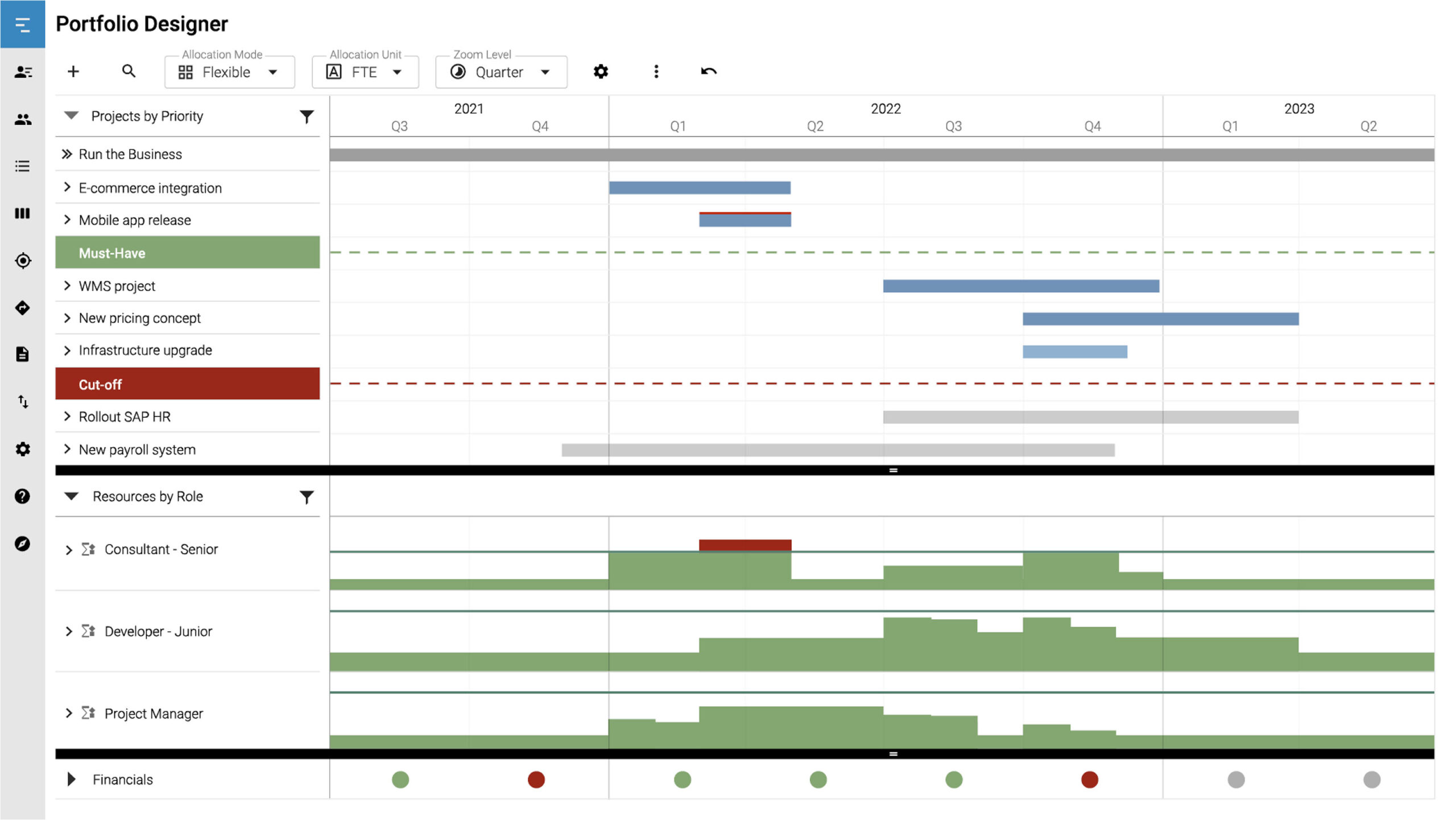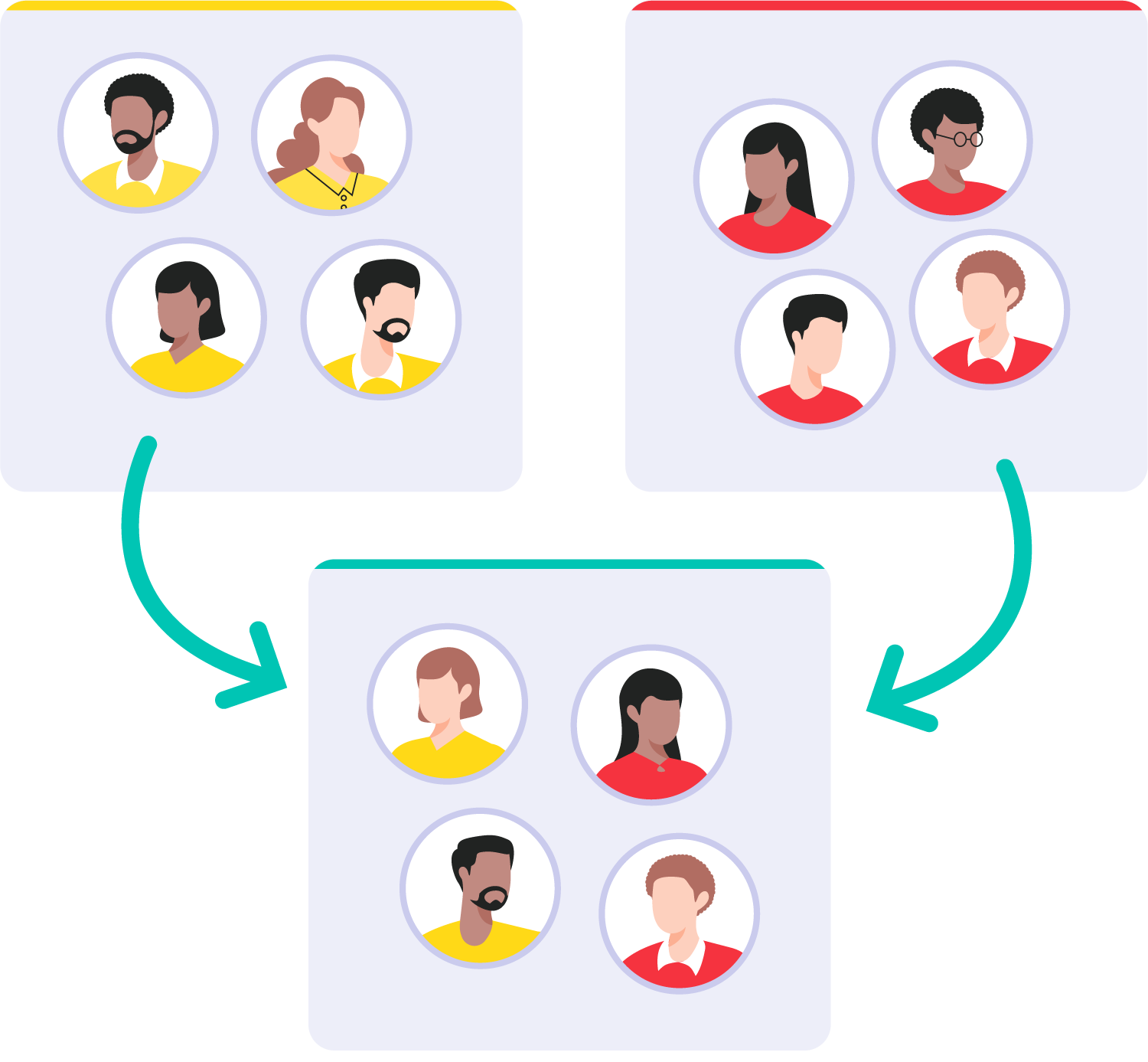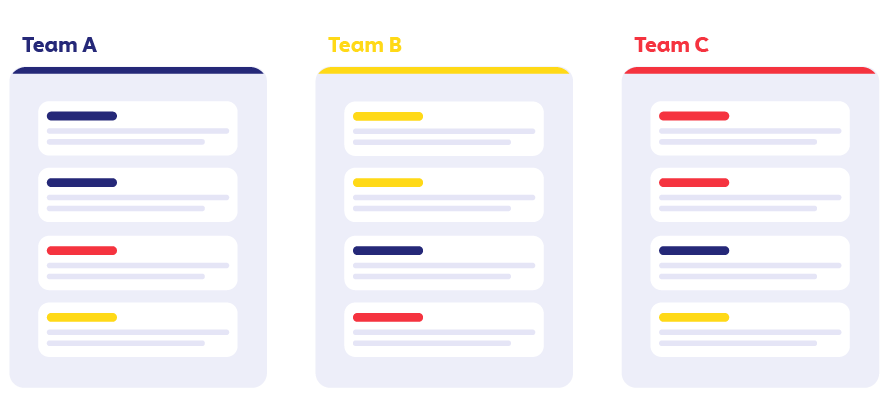In this blog post, we’re trying to condense everything we know about project portfolio management. It’s quite a read, so get your favorite warm or cold brew ready. Ready, set, go!
Table of Contents
Project Portfolio Management (PPM) in a Nutshell
Why It’s a Good Idea to Do Project Portfolio Management
The difference between portfolio management, program management and multi-project management
Project Portfolio Management 101 – A Cookbook
There’s More to PPM – The 4 Pillars
Advanced Project Portfolio Management
How to introduce PPM to your organization
Pitfalls of Project Portfolio Management and How to Address Them
Conclusion – Successful organizations manage their project portfolio
Small shops, medium-sized businesses, large enterprises — there’s one thing that unites them all: they want to create this new product, complete this important project, or make an internal change. The drive for growth, efficiency and excellence is a universal ambition that goes beyond the size of an organization.
Another thing that unites organizations is that there aren’t enough resources to do all the great work everybody would love to carry out. Organizations are constrained by their scarce resources. Every one of them. No exceptions.
What all organizations need is to choose the right people for the right projects at the right time. This is called Project Portfolio Management.
With Project Portfolio, organizations can:
- focus on the right projects by aligning them with the company's goals and strategy.
- optimize resource usage by lining up projects according to their resource needs while paying attention to bottlenecks.
- actively manage risks by consciously selecting, canceling or resuming projects with a certain risk exposure.
- streamline decision-making processes, make prioritization criteria transparent and get better insights into investments.
- swiftly respond to change in environment, competition or organizational strategy.
- react faster to upcoming issues and understand the consequences of changes to the portfolio.
Project Portfolio Management (PPM) in a Nutshell
Project Portfolio Management (PPM) is the discipline of analyzing, prioritizing, selecting and monitoring the right projects for the organization. Just like financial portfolio management, where a portfolio consists of financial assets with certain profit outlook and risk exposure, a project portfolio is the expression of the organization’s appetite for risk and for returns in order to maximize the return on investing its monetary and personnel resources.
Why It’s a Good Idea to Do Project Portfolio Management
PPM can be a great lever to enable organizational success. By including all stakeholders in the process, the organization becomes more efficient, wastes less resources on the wrong investments, gets everybody on the same page and streamlines the creation of value. The staff will work on the right projects without being overloaded or bored.
Ignoring PPM is short-sighted
I remember talking to a CEO a couple of years back. We had a discussion about the value of balancing projects and available resource capacity. He told me that he actually didn’t care that much about how much burden projects put on his staff; he just wanted to get the work done. Another CEO told me that resources were never a problem, as there were always outside contractors available in abundance to take over the work.
I disagreed back then, and I disagree even more today. In times of skilled labor shortage, it’s simply not possible to fill lacking internal capacities using contractors. And it’s even harder to find enough internal people for the important jobs. Nowadays, the need to select the right projects for the scarce resources available and to aim for a “sustainable pace” are key to dealing with people.
So, negatively put, organizations that do not actively monitor their project portfolios run the danger of:
- not knowing what is happening in the organization, especially where problems are or could arise.
- wasting resources on the wrong projects, or even on redundant projects
- risking wait times for projects through bottlenecks that are blocking other projects.
- running projects which were heavily advocated for by people with influence, not projects that contribute the most to organizational goals.
The difference between portfolio management, program management and multi-project management
When I met my first “real” program manager back in 2005, I was impressed. This guy was intelligent, kind and IT savvy — a jack of all trades, managing a program with an 8-figure budget. He was the one to tell me that the difference between multi-project management and program management is that a program aims to generate more value than the sum of all projects would individually.
To summarize:
Project Portfolio Management
has a strategic perspective on the whole organization. It is about selecting and monitoring the right investments that promote the company’s strategy. This means that the organization is aligning its operative focus to the strategic objectives. i.e., strategic alignment. Furthermore, a portfolio has a clear start and end — independent of the duration of the projects in it. It can be considered a fiscal cut or fiscal budget.
The following graph summarizes Traditional PPM nicely. It shows that projects are collected, decided upon and then executed.
Cf. Dammer, Henning (2007): Multiprojektmanagement.
Program management
focuses on executing a bundle of projects that align with a common goal. In combination, these projects create more value than the sum of all the projects would individually. The program coordinator focuses on coordinating resource demands, schedules and results. A program lasts until the final projects end. Programs usually take a long time — at least months. Complex programs can span across many years and budget cycles.
Multi-Project Management
refers to the discipline of carrying out multiple projects at a time while trying to ensure that every project reaches its goals. In contrast to program management, where all projects work towards a common goal and typically have dependencies, a project coordinator allocates shared resources or skills across different projects, even if they are unrelated.
Make sure to check out this detailed article about the difference between project portfolio management and program management here.
Project Portfolio Management 101—A Cookbook
Urgh, unpleasant memories arise when I think back to my first “real” PPM workshop in the early 2000s. Everything started out great. We had a common understanding of selecting all the project ideas and capturing them in one tool. The mood was great, the seniors (one was smoking a pipe, no joke!) were satisfied and thought I was on the right path.
Everything changed when I tried to understand what their strategy was and how this strategy could be applied to projects. The room became silent, and nobody had a clue about the company’s strategy. Nobody knew how to apply a fuzzy strategy onto projects. Long story short, the workshop went downhill, and we ended it pretty early. Ouch.
From all the other PPM workshops, the lessons we learned and the mistakes we made, we have compiled a list of suggestions that every company should follow to successfully establish a PPM practice:
- Have a company strategy/business goals. At best, have a strategy for the mid-term that can actually be used to decide if a project supports that strategy or not. What works best from my experience is to work with an "objective key result" (OKR) approach, either on a yearly or quarterly basis.
- Break down the company strategy/business goals into different aspects and offer compliance levels for each evaluation criteria. For example: Goal: "Reduce carbon footprint by 10%". Compliance levels: "not at all; somewhat; mostly; yes".
- Collect all project candidates. This process can take the form of a very classical "demand management" process or a more modern approach where a backlog of epics/business epics/features are collected.
- Capture the resource demand for each idea. Estimate additional financial costs (external costs like contractors as well as capitalizable investment costs) and potential benefits (revenue, cost savings etc.). Eventually, create a risk profile for each project and estimate the project complexity.
- Capture carryover projects separately and update the remaining financial and resource demands.
- Discover dependencies between the different projects. These can be (1) the inability to start without the delivery of another project, (2) the need for deliverables from another project at a certain point of the execution, or (3) creating synergy between mutually beneficial projects.
- Measure all project ideas against the evaluation criteria. By doing this, a prioritized list will emerge.
- Take inventory of financial resources (CapEx and OpEx budgets) as well as resource capacities across departments, roles and skills.
- Check the feasibility of the project portfolio, considering financial and resource constraints, benefits and risk profile. This will lead to different alternatives.
- Have executive leadership make a final decision.
- Communicate the portfolio to all involved stakeholder groups, especially individual project managers.
- Start the individual projects by assigning an agile team or project team, a project coordinator/manager and a definite time period.
- Monitor the project progress. Provide comprehensive management dashboards to understand the status quo. Maintain communication between executive stakeholders, project managers, resource managers and project portfolio managers.
- Reflect on your PPM system; streamline portfolio management and project management processes, try to eliminate waste and take small (or sometimes large) steps to drive continuous improvement.
- Start over.
There’s More to PPM — The 4 Pillars
You’ve probably already seen that there are different dimensions at play when talking about PPM. Every single one needs to be addressed. They can be categorized into 4 pillars, which are:
- A robust PPM process. This means capturing projects in their early idea stages and accompanying them until the end.
- A structural unit, with jobs, roles and accountability.
- A set of meetings, checkpoints and deliverables.
- A tool to capture all data, run simulations, save baselines and track progress.
A Robust Project Portfolio Management Process
The exact implementation of the right PPM process for your organization will, of course, differ. From what we’ve learned, at least these four areas need to be implemented:
- Strategize - Translating Your Business Strategy
The business strategy for an organization is determined by senior management. Strategic objectives need to be translated into criteria to evaluate projects and determine their priority. All projects, including those already in progress, should be evaluated and prioritized based on the established criteria.
- Collect - Collecting Project Proposals
Potential projects are proposed, and project initiatives need to be created with a description, benefit estimates and effort required. In addition, proposal coaching has to take place where a portfolio coordinator and the project initiator discuss the idea, enhance it and decide whether it should proceed to the next step. If there are different committees in your organization that review and decide on various project types, the portfolio coordinator will guide the initiative to the appropriate committee.
- Decide - Deciding Which Projects Will Be Implemented
A portfolio board meeting is the highest-level decision-making committee for PPM. The portfolio board monitors overall progress, resolves conflicts, confirms the portfolio's composition and decides on future resource deployment. Finally, the decisions from the portfolio board meeting are communicated throughout the company, project managers are selected and resources are staffed.
- Execute – Managing Approved Projects
Transparent communication between teams about project progress and requirements is crucial for successful project execution. Any conflicts that arise during project management are escalated to the project portfolio managers/the execution steering committee. Only issues that cannot be resolved within this process are brought up in the portfolio board meeting.
Looking for something to start with?
Have a look at our in depth description of what we consider an essential PPM process. We call this Lean PPM™.
An Organizational Structure with Clear accountability
PPM is not a one-time activity — quite the contrary. It is an organizational function that successful organizations run with dedicated personnel. This is typically hosted in the Project Management Office (PMO), a Project Portfolio Management department or another specific staff department attached to the CEO or CFO office.
Please refer to our complete list of roles and responsibilities that need to be either established or involved to run a successful PMO operation. The most important jobs/roles that need to be taken over in PPM are:
The project portfolio manager (or portfolio coordinator) is the owner of the PPM process, the facilitator and guide of the project portfolio board, the person responsible for the translation of the strategy into tangible prioritization criteria, the person preparing decision meetings and (perhaps most importantly) the person who stays in touch and actively communicates with executive stakeholders.
Project Managers/product owners are people who take over responsibility for the implementation of a project or the success of a product. They report the project progress or status of the product implementation, escalate issues and present their capacity demands to the decision-making board.
Resource Managers staff people on projects, make sure their people are neither overworked nor bored, look after long-term development (of hard and soft skills) and resolve issues in the day-to-day minutia.
Meetings, Checkpoints, Deliverables
Along the PPM process, certain meetings have to take place. These meetings are necessary to communicate business objectives, synchronize stakeholders, select the right projects and monitor their progress. The most essential meetings to set are:
- A portfolio board meeting in which decisions are made about approving, stopping or changing the resourcing of projects.
- A Pipeline Review Committee Meeting is the meeting that prepares a tentative portfolio (or many) through a ranking of investments and a thorough check of their feasibility.
- A meeting to resolve resource conflicts on the operational level.
- Executing steering meetings, in which the status of single projects is monitored and problems are discussed and potentially overcome.
All these meetings are explained in more detailed in our free downloadable summary of the Lean PPM Meetings here.
A Project Portfolio Management Software Tool to Support All Stakeholders of the PPM Process
Along the whole PPM process, project portfolio management software has to support decision makers, operational managers and team members doing their jobs. That means:
- PMOs and project portfolio managers need to be supported to gather data and make plans that actually work, through questionnaires, evaluation criteria, automatic ranking of projects and simply sorting out wrong projects.
- Executives need comprehensive dashboards and reports to decide on different investment alternatives and to understand and monitor the progress of the current portfolio.
- Resource managers can understand what is going on and put the right people on the right jobs.
- Project managers can report in a simple fashion to get money and capacity from the portfolio board.
- Last but not least, team members know what they’re supposed to work on at any given moment.
There is already a vast set of tools on the market. There is a great bandwidth spanning from simple Kanban boards to sophisticated “all-in-one solutions”. We at Meisterplan have been trying to create a project portfolio management software that supports all roles in an easy and intuitive way.

Advanced Project Portfolio Management
Okay, that was it for the basics of PPM. Modern companies have changed the way they deal with their project portfolios. This means that their portfolios have become too big to handle or that they’re working in a less “plan driven” way. Let me explain a couple of ways to deal with this:
Structure Portfolios into Sub-Portfolios
Organizations running less than 50 projects typically only need one project portfolio. However, for organizations running more projects or with different lines of business, separate resource pools or multiple locations, it may be beneficial to structure the portfolio into sub-portfolios.
Everything is fairly simple as long as the portfolios are separated and there are no dependencies between projects within the different portfolios. The complete budget of the whole organization is split up between the separate portfolios, portraying the company’s general business goals and priorities.
These dependencies can be subject matter dependencies (e.g., project B waits for a deliverable from project A) or resource dependencies (e.g., project B has to wait because a critical resource is still working on project A).
To overcome this, we suggest this structured approach:
- Plan all independent projects of the sub portfolio.
- Spell out all subject matter and all resource dependencies between the projects of each sub portfolio.
- Get in synch with the project portfolio manager of the other portfolio and discuss if conflicts can be overcome by changing the timing of the project.
- Meet in a portfolio board that has the authority to make top-down decisions and to prioritize projects across organizational units.
- Adjust plans according to the portfolio board's decisions.
The visualization of dependencies and the transparency that is needed to get all portfolio managers in sync calls for a tool.
An Agile Approach to Project Portfolio Management
Modern approaches like SaFe (Scaled Agile Framework) break the organization down into value streams. Comparable to the sub-portfolios we looked at above, a value stream can be considered as a business service, product or customer journey. Money is not distributed in absolute sums but rather in percentages, indicating where the company sees the priority “at the moment”. Each value stream consists of ARTs (agile release trains) which, in turn, consist of several agile teams, typically following a scrum or kanban approach.
SaFe implements a so-called Lean Portfolio Management approach. It includes processes, responsibilities, evaluation criteria and metrics to make sure the organization is focusing on the right things and the project teams are delivering the right outcomes.
SaFe compared to other project management methods
The main difference between a traditional project management approach and the SaFe framework is that the latter focuses on something called the “portfolio backlog”. Instead of managing individual projects with a start and end date, SaFe organizes work into epics. These epics are prioritized in the portfolio backlog based on the strategic objectives and value they bring to the organization. Then, following agile principles, they are worked on “as soon as possible”.
In my personal experience, however, even very agile organizations want to know when things will be done. This is why agile teams utilize roadmaps to determine future work and establish expected timelines for results. What sets them apart is the way they deal with effort estimations.
But how do you estimate effort in agile work?
- Story Points and Team Capacities
Each work item (e.g., epic, feature, etc.) is estimated in story points. Every team has a velocity (per sprint/per month/per quarter). The exercise then is to determine which team can take over the work item, make sure that no dependencies are broken and that the total capacity in story points is not exceeded.
- Efforts
Instead of using story points, estimations are "normalized" into efforts in hours or days. These are then used to select the work items and balance them with the available team capacities. The upside of this approach is that effort estimations by the hour can be used to distribute the work across teams. This shouldn't be done with story point estimations as they are very team specific and cannot be applied to other teams.
How to Deal with Cross-departmental Projects (Traditional and Agile)
There are multiple ways to deal with cross-departmental projects. Depending on the size and the duration of the project:
- a new project team with resources from all involved departments can be formed
- or projects can be split into sub-projects that are run by different project teams with an extra, overarching program manager.

- For agile organizations, projects can be broken down into epics/features/user stories and separately run in the scrum/kanban cadence of each team. Also here, a project coordinator takes care of keeping everybody in synch and making sure that the stories are prioritized in each involved team in the right order to be delivered at the right time.

For a more intense look at this topic, refer to our blog post on this topic.
Budget or People? What is the real constraint?
To answer very briefly: both are important. Without financial resources, no investments can be committed to. Without people, nobody will carry them out.
Focusing on only one or the other will not work:
- Focusing on people only neglects that people cost money, and this money has to be made available to pay people, and to pay for operational expenditures on projects as well as capitalize investments.
- Focusing only on money is a problem because one single bottleneck in the company can wreak havoc on the complete portfolio and, through that, endanger the delivery of all projects. This would jeopardize go-to market deadlines, prevent the company from reaching its strategic goals or simply put people in unproductive waiting patterns.
So, a portfolio has to be balanced from both financial and resource management perspectives while at the same time respecting the project-interdependencies. This is not an easy task and has to be supported through a software that allows the creation of multiple scenarios side by side.
Get People Involved
All your stakeholders will support you in introducing PPM if they get something out of it. We call this the “PPM Deal”. The core part of the deal is between the people running the projects and the executive team of the organization.
“Regularly provide status updates and future estimates, in return you will be granted capacity and freedom to run your project.”
In the following graph we have condensed how people can be involved and what the benefit it is for them to actively participate in PPM.
How to introduce PPM to your organization.
After hundreds of implementations, we have come up with a simple, seven-step approach on how to introduce PPM to your organization. The steps are:
Step 1: Clarify your goals/business outcomes
Step 2: Set up the PPM process
Step 3: Invite process participants to the project portfolio management tool
Step 4: Train the participants
Step 5: Set up meetings
Step 6: Establish responsibilities
Step 7: Leverage the knowledge of others
You will find more information on each step and on how to set yourself up for success on these pages. Plus, keep in mind that taking the first step can be difficult. Don’t do everything by yourself — connect with peers, such as colleagues or PPM experts from other companies or PM organizations. Meisterplan provides regular roundtables where you can meet PPM experts, have discussions about real problems and receive assistance. Click here to sign up for the next one.
Pitfalls of Project Portfolio Management and How to Address Them
While there are many benefits, PPM also has its risks. So, before making a mess, have a look at some of these lessons learned.

Try to keep it as simple as possible. Speak to people first and convince them before over-bureaucratizing.
Make sure your Lean PPM portfolio captures only the bare minimum amount of data necessary to make decisions.
Make your stakeholders aware of the benefits of PPM (see above) and make it clear that this is not a job reduction or employee squeezing machine, but quite the contrary; this is a tool to help attain a sustainable pace of work on the projects that matter.
- Have a tool that makes it easy to enter or collect just the data that you need.
- Use interfaces and APIs to avoid double data entry.
Onboard stakeholders early; listen to their reservations and address them.
Have your project portfolio managers communicate early that the very nature of projects is that risks are taken. A healthy project portfolio consists of a mix of high and low risk projects. As a consequence, some projects will go wrong.
Project portfolios managers have to make sure the data of their portfolio is:
- up to date
- trustworthy
- resilient
Again, this can be achieved through a deal between project portfolio managers and project managers:
“I will not interfere with the day-to-day details of your project, as long I will get a short and trustworthy update about the project on a regular basis”
Also make sure to check our document on “a productive start to PPM“, which also contains a ton of best practices.
Conclusion – Successful organizations manage their project portfolio
PPM is an effective way to align organizations with their goals and objectives. By streamlining processes, engaging the right roles, and leveraging the right tools,
- the organization takes a holistic view of all projects — not just the ones that generate the most buzz — weighing risks and rewards in the fight for scarce resources.
- projects are aligned with strategic objectives and strategic goals.
- there is enough budget to execute selected projects.
- resource allocation is optimized for maximum efficiency and productivity.
- competing projects as well as synergies between projects are identified.
- the organization balances its risk exposure by selecting a mix of projects with higher or lower risk profiles.
- everybody is informed and everybody knows who is responsible.
We encourage organizations of all sizes to think about their strategic objectives, take inventory and consciously decide where to spend their money and resources in order to achieve the best result.
As a next step we suggest to have a look at the Meisterplan Help Center regarding your first steps with introducing PPM. Good luck!
P.S. And: Please do get in touch in case we forgot something, misspelled PPM or we’re plainly wrong somewhere!



